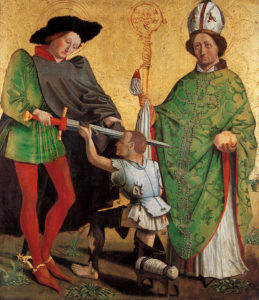All Saints Day and All Souls Day are behind us. You may still have Halloween hangover in your house depending on how long the candy lasted. Soon, attention will turn fully to Thanksgiving.

Before entering the world of pumpkin pie, I’d like to reflect upon two commemorations occurring on November 11. The first, of course, is Veterans Day, an American holiday proclaimed first as Armistice Day by President Woodrow Wilson to honor the official cessation of hostilities in World War I in 1918.
By 1954 Armistice Day had been retitled Veterans Day and blended into a broader celebration of all those who served in the American military. Growing up among adults from the “Greatest Generation,” I received a positive understanding of Veterans Day in our school curriculum and remember well the enthusiastic parades, respectful silences, and heroic stories retold and honored.
But, alas, veterans are no longer esteemed in our mass culture. Percentagewise, few of our citizens serve. The commonalities and traditions of military service that once bound people together are scattered to the wind.
The end of World War I is celebrated across Europe on November 11. But commemorations, not as familiar, share this day, including the celebration of the life of St Martin of Tours. He is considered a patron saint of soldiers, but that’s not what most people think of when they hear his name.

St Martin was born in what today is Hungary, probably in 316, and lived in an era when Christianity was still a newly legalized religion in the Roman Empire. Raised to be a career soldier, he ultimately left military service, finding it incompatible with his ever-strengthening Christian beliefs. The most famous story about St Martin occurred while he was still a soldier and stumbled across a poor, unclothed man. He responded to this man’s needs by slicing his cloak in two with his sword.
Once he devoted himself fully to God, he strove to live his life in simplicity, including living as a hermit. But he found himself repeatedly drawn into the complex issues surrounding the developing Christian faith and served in many capacities, including being appointed Bishop of Tours.
Yet the German, French, and Italian children parading through the streets after sunset on November 11 think little about Martin’s theological battles. For them, St Martin’s Day is a beloved children’s festival where they decorate paper lanterns and process through the streets. Often towns or churches will present the drama of St Martin in an open square or on the steps of a church, replete with a real horse for the actor playing St Martin. You’ll get an idea of how such a version might look in this clip from Kempen, Germany, complete with bonfire.
Last year our granddaughter was able to participate in St Martin’s Day festivities while in Weimar, Germany. Alas, it rained hard that evening, but the families were still out, plastic bags protecting the delicate lanterns illuminated by wobbly candles and battery-fed flashers.
Once darkness fell, we gathered at the steps of the Catholic Church under a canopy of umbrellas to hear costumed figures sing the narrative, accompanied by medieval instruments. A silvery horse stood waiting for “St Martin” to spring on its back and lead the procession. By the time we sloshed our way into the main square, we were drenched. Rather than stay to participate in the games launched from a temporarily erected stage, we ducked into the first cozy café we found.
We weren’t alone. It was crammed with rain-soaked kids, worried whether their lanterns were still in one piece. Steaming cocoa and plum cake went a long way toward restoring our spirits. The rain let up just enough to let us for us to process back home, singing robustly.
We are going to have our own Texas-style St Martin’s parade this year. We’ll enlist neighborhood kids to join us in constructing and decorating lanterns. We’ll learn a few songs, too, including our two favorites: Ich gehe mit meine Laterne. (I walk with my Lantern) and Laterne, Laterne (Lantern, Lantern).
Once these tunes enter your ear, you may have a hard time losing them. They’re not quite as invasive as Wheels on the Bus, but they are infectious. Consider yourself forewarned!
Thinking about these two events—one a tribute to our soldiers and the other a celebration of a soldier of God—I’m reminded how important it is to observe and teach traditions. A child learns incalculable lessons by watching the laying of a wreath or by cheering a parade of proud veterans who survived crucial events in our history. And even though couched as a sweet children’s festival, a commemoration like St. Martin’s Day links us with the tumultuous days of our early Christian history. Tradition provides the content, the context, and a ready means of grasping difficult things. As year leads to year, understanding deepens, so that these same traditions can be passed on as gifts to the next generation.



